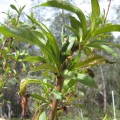Common Fungal Diseases:
- Aster Wilt
- Cabbage Yellows
- Downy Mildew
- Foot Rot or Root Rot
- Fungal Canker
- Fungal Leaf Spots
- Alternaria
- Cercospora
- Coccomyces
- Coryneum
- Cristulariella
- Mycosphaerella
- Phyllosticta
- Physalospora
- Venturia
- Fusarium Wilt
- Gladiolus Corm Rot
- Narcissus Basal Rot
- Peach Leaf Curl
- Phytophthora
- Powdery Mildew
- Pythium
- Rust
- Snow Mold
- Turf Drought
- Verticillium Wilt
Transmission:
- AHSP&D-72: Most fungal infections are spread from plant to plant or within a plant by spores. These are occasionally large enough to be visible with the naked eye. Their type, size, and quantity depends on the specific fungus. Most spores are spread either on air currents or by rain splash.Soil borne spores can be taken in with soil moisture by the root system. Some, like Phytophthora, can actually prpel themselves in water. These are called zoospores. Weather conditions creatly affect disease spread and development, and in most cases moisture on the plant surface encourages infection and spread. Humidity and the resultant film of moisture on the plants may also cause a marked increase in disease spread and development.
- TWM-63: soil-borne fungi enter through the roots; pathogenic and parasitic fungi make use of various entry points into plants, including stomata (the openings on leaf surfaces that allow plants to breathe) and wounds. Some fungi can dissolve the cuticle and cell walls of the plant.
Symptoms:
- leaves, branches, twigs or flowers suddenly wilt or become brown and die
- often the stem appears water-soaked and blackens at the soil line
- rotting roots or the lower part of the stem
- can be systemic, throughout the plant, but the majority are restricted to certain plant parts
Controls:
- hygienic cultivation practices: sterile tools, gloves, soil, water; removing infected debris from garden site; buying disease-free plants or seedlings
- watering at soil level, not overhead
- TWM-62: beneficial fungi compete for nutrients and form protective webs and nets, often in conjunction with bacteria, around roots (and even on leaf surfaces, as leaves produce exudates that attract bacteria and fungi as well); this prevents some of their pathogenic and parasitic fungal cousins from invading the plant.
Treatments:
- OPDC-30: Fungicidal soap formulations, most organically acceptable, made of sulfur and fatty acids control mildews, rots, leaf spots, and rust. They are sold as a liquid formulation, then sprayed on the affected plant. Generally very safe and break down rapidly in the soil, but they can be poisonous to plants, so test them on a msall portion of a plant and wait a day or tow to make sure no damage is evident before spraying the whole thing. Thorough coverage and periodic reapplication are needed for good control
- OPDC-33: Sulfur, copper, and lime — applied as dusts or mixed with water — are primarily used to control fungal and bacterial diseases, including mildews, rots, leaf spots, and blights. sometimes these minerals are sold in a combined formulaton, such as copper sulfate, or bordeaux mix, a mix of copper sulfate and hydrated lime. Sulfur dust, lime, and lime-sulfur control some plant-sucking pests as well. Sulfur is relatively nontoxic to humans; the toxicity of copper varies depending on the formulation. Whether you apply minerals as a dust or a spray, protect your eyes, lungs, and skin to avoid irritation.
- BBGS-207: Fungicides may be eradicants, which kill or neutralize fungi living in the soil or on the plant, or protectants, which prevent the growth of fungi on susecptible plant parts. While there are a wide variety of products on the market, it is difficult to find effective, all-purpose fungicides that meet the safety standards demanded by organic gardeners. In the past, orchardists routinely used sulfur preparations like Bordeaux mixture (a mix of lime and copper sulfate discovered by French vinyardists in the 19th century). Similar commercial preparations are still readily available. Promising new products use beneficial fungi to fight more harmful species.
Sources:


